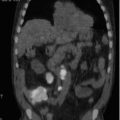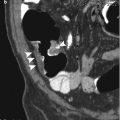and Clarisse Dromain2
(1)
Department of Radiology, San Giovanni Hospital, Roma, Italy
(2)
Department of Radiology, Institut de Cancerologie Gustav Roussy, VilleJuif – Paris, France
Abstract
Neuroendocrine tumors (NETs) are a wide-ranging group of rare tumors that develop from neuroendocrine cells. The most common NETs arise from the gastrointestinal tract (including ileal and appendiceal tumor), lung, duodenum, and pancreas. Less often NET tumors can arise from the rectum, the stomach, the esophagus, and the larynx. NETs share common clinical features including hormone secretion, their possible association with an inherited syndrome, and a long-term natural history in a subgroup of well-differentiated endocrine carcinoma. The two main prognostic parameters in NET are pathological differentiation and histological grade defined, according to the values of the mitotic index and Ki67 index. NETs can be benign or malignant, but their histological features are not sufficiently predictive of malignant behavior: invasion of adjacent organs or structures or metastatic lesions are often required to formally establish malignancy.
Neuroendocrine Tumor
Neuroendocrine tumors (NETs) are a wide-ranging group of rare tumors that develop from neuroendocrine cells. The most common NETs arise from the gastrointestinal tract (including ileal and appendiceal tumor), lung, duodenum, and pancreas. Less often NET tumors can arise from the rectum, the stomach, the esophagus, and the larynx. NETs share common clinical features including hormone secretion, their possible association with an inherited syndrome, and a long-term natural history in a subgroup of well-differentiated endocrine carcinoma. The two main prognostic parameters in NET are pathological differentiation and histological grade defined, according to the values of the mitotic index and Ki67 index. NETs can be benign or malignant, but their histological features are not sufficiently predictive of malignant behavior: invasion of adjacent organs or structures or metastatic lesions are often required to formally establish malignancy.< div class='tao-gold-member'>Only gold members can continue reading. Log In or Register to continue
Stay updated, free articles. Join our Telegram channel

Full access? Get Clinical Tree





